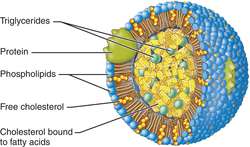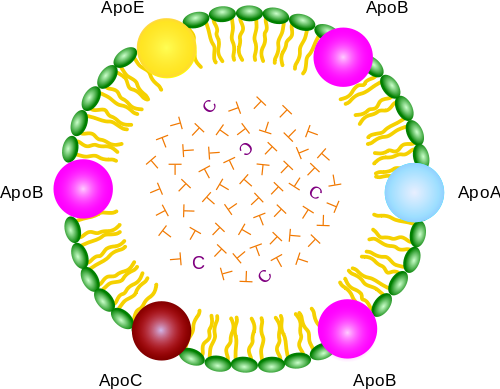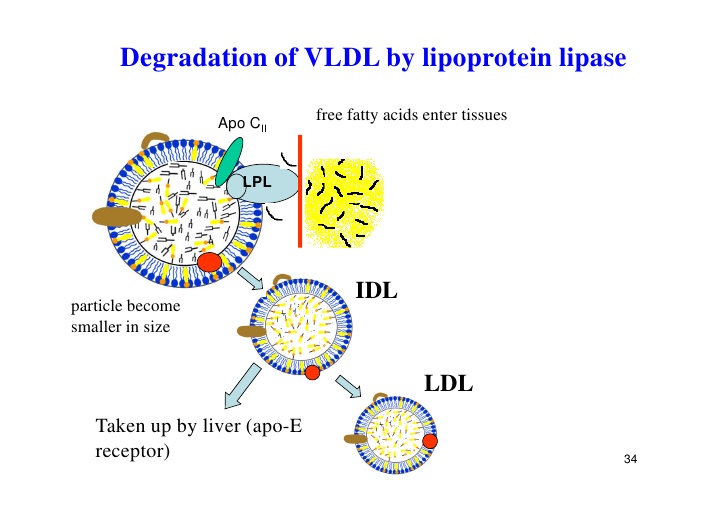Cholesterol, Lipoproteins and the Liver
Lipids are transported in the circulation packaged in lipoproteins.
The clinical relevance of blood lipid levels is that abnormal
levels of lipids in certain lipoproteins are linked to an increase
risk of atherosclerosis. Atherosclerosis is a
cardiovascular disease in which lipids and inflammatory cells
accumulate in plaques within the walls of blood vessels. As a
result, vessel walls are narrowed and clots may form, impeding
blood flow and oxygen delivery and causing tissue injury. Heart
disease occurs because the coronary arteries supplying the heart
are a major site where atherosclerotic plaques form.
The liver is central to the regulation of cholesterol levels in
the body. Not only does it synthesize cholesterol for export to
other cells, but it also removes cholesterol from the body by
converting it to bile salts and putting it into the bile where it
can be eliminated in the feces. Furthermore, the liver synthesizes
the various lipoproteins involved in transporting cholesterol and
other lipids throughout the body. Cholesterol synthesis in the
liver is under negative feedback regulation.
Increased cholesterol in a hepatocyte leads to decreased activity
of HMG-CoA reductase, the rate-limiting enzyme in
cholesterol synthesis.
Many important molecules in the body are lipids. But transporting these molecules around the body
through the blood presents an obvious problem, because, by definition, lipids are nonpolar and thus not very
soluble in water. Small amounts of fatty acids are transported in the blood bound to blood proteins. These
are called free fatty acids (despite the binding). Beyond this, however, other lipids are transported in
special particles called lipoproteins.
To emphasis, lipoproteins are not molecules, but rather particles comprised of several thousand
molecules. These particles solve the problem of lipid/water incompatibility via the amphipathic nature of phospholipids. One end of these molecules is polar and the other end nonpolar.
 Lipoproteins have a single layer of phospholipid molecules on their outside, surrounding a central core. (By contrast, plasma membranes are comprised of a BILAYER.) Since the polar part of each phospholipid faces out, the outside of the phospholipid molecule is polar and thus compatible
with the surrounding water environment. On the other hand, the nonpolar portion of each phospholipid faces
inward, and thus is compatible with the very nonpolar ingredients of the core of the lipoprotein. In addition, some cholesterol is found in the outer layer of phospholipid.
Lipoproteins have a single layer of phospholipid molecules on their outside, surrounding a central core. (By contrast, plasma membranes are comprised of a BILAYER.) Since the polar part of each phospholipid faces out, the outside of the phospholipid molecule is polar and thus compatible
with the surrounding water environment. On the other hand, the nonpolar portion of each phospholipid faces
inward, and thus is compatible with the very nonpolar ingredients of the core of the lipoprotein. In addition, some cholesterol is found in the outer layer of phospholipid.
As shown in the figure, the outer layer of the lipoprotein also has a protein molecule called an apolipoprotein. Like phospholipids, this protein is amphipathic and helps stabilize the particle. But even more important, the protein serves to identify the specific lipoprotein. For example, some lipoproteins transport dietary lipids from the small intestine to adipocytes and the liver. Other lipoproteins transport cholesterol between different part of the body. Each type of lipoprotein can be identified because it has
a different apolipoprotein.

At the target cell, in some cases, the apolipoprotein binds to a receptor and then the lipoprotein
is then taken up by receptor mediated endocytosis. In other cases, an enzyme on the capillary wall, termed lipoprotein lipase, unloads triacylglycerol from the lipoprotein by breaking triacylglycerol into fatty acids and glycerol.
(The terminology here often confuses students. Remember the lipoprotein is a particle, the
apolipoprotein is a protein that is part of the particle.
The core of the lipoprotein contains the most nonpolar substances. A lipoprotein formed in the small intestine, for example, would have much triacylglycerol (triglyceride) derived from the diet. Esterified cholesterol is also found in the core. ( "Esterified" means that a fatty acid is combined with the cholesterol at its one vaguely polar spot to make an even more nonpolar molecule.) A small amount of ordinary cholesterol is also found in the phospholipid outer layer.
- Chylomicrons and VLDL deliver Triglyceride/Triacylglycerol to cells in the body.
Two types of lipoproteins are triglyceride-rich: the
chylomicrons and VLDL. Chylomicrons are synthesized by
enterocytes from lipids absorbed in the small intestine. VLDL is
synthesized in the liver. The function of these lipoproteins is
to deliver energy-rich triacylglycerol to cells in the
body. Triacylglycerol is stripped from chylomicrons and VLDL
through the action of lipoprotein lipase, an enzyme that is found
on the surface of endothelial cells. This enzyme digests the
triacylglycerol to fatty acids and monoglycerides, which can then
diffuse into the cell to be oxidized, or in the case of an adipose cell,
to be re-synthesized into triacylglycerol and stored in the
cell.
- LDL delivers cholesterol to cells in the body. As VLDL
particles are stripped of triacylglycerol, they become more
dense. These particles are remodeled at the liver and
transformed into LDL. The function of LDL is to deliver
cholesterol to cells, where it is used in membranes, or for the
synthesis of steroid hormones. Cells take up
cholesterol by receptor-mediated endocytosis. LDL binds
to a specific LDL receptor and is internalized in an
endocytic vesicle. Receptors are recycled to the cell surface,
while hydrolysis in an endolysosome releases cholesterol for use
in the cell.
- HDL is involved in reverse cholesterol transport.
Excess cholesterol is eliminated from the body via the liver,
which secretes cholesterol in bile or converts it to bile salts.
The liver removes LDL and other lipoproteins from the
circulation by receptor-mediated endocytosis. Additionally, excess
cholesterol from cells is brought to the liver by
HDL in a process known as reverse cholesterol transport. HDL
returns the cholesterol to the liver.
So how does the cell get the triglycerides, fatty acids and cholesterol from the lipoprotein?
 As you can see in this diagram, the enzyme Lipoprotein Lipase (LPL) is attached via a branching glycoprotein
As you can see in this diagram, the enzyme Lipoprotein Lipase (LPL) is attached via a branching glycoprotein
called Heparin Sulfate to the inside of the capillary; anchored to the endothelial cell.
Lipoprotein lipase enzymatically degrades the contents of the lipoprotein and releases some
of the contents of this lipoprotein into the blood next to the endothelial cell. These particles
can pass through the endothelial cell of the capillary wall and enter the cell directly.
And notice in the diagram, it is the apolipoprotein on the surface of the lipoprotein that binds
it to the LPL.
 Lipoproteins have a single layer of phospholipid molecules on their outside, surrounding a central core. (By contrast, plasma membranes are comprised of a BILAYER.) Since the polar part of each phospholipid faces out, the outside of the phospholipid molecule is polar and thus compatible
with the surrounding water environment. On the other hand, the nonpolar portion of each phospholipid faces
inward, and thus is compatible with the very nonpolar ingredients of the core of the lipoprotein. In addition, some cholesterol is found in the outer layer of phospholipid.
Lipoproteins have a single layer of phospholipid molecules on their outside, surrounding a central core. (By contrast, plasma membranes are comprised of a BILAYER.) Since the polar part of each phospholipid faces out, the outside of the phospholipid molecule is polar and thus compatible
with the surrounding water environment. On the other hand, the nonpolar portion of each phospholipid faces
inward, and thus is compatible with the very nonpolar ingredients of the core of the lipoprotein. In addition, some cholesterol is found in the outer layer of phospholipid.
 As you can see in this diagram, the enzyme Lipoprotein Lipase (LPL) is attached via a branching glycoprotein
As you can see in this diagram, the enzyme Lipoprotein Lipase (LPL) is attached via a branching glycoprotein